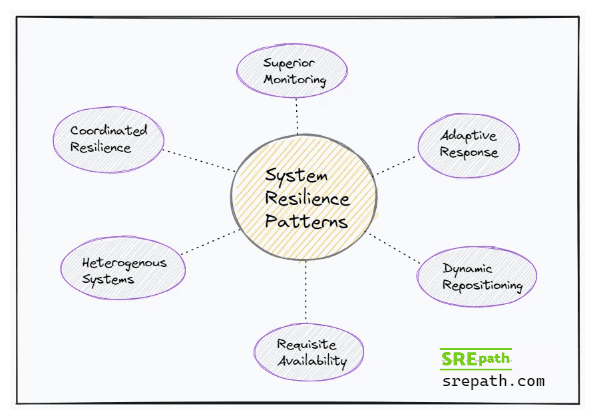Introduction
System resilience thinking can inform better Site Reliability Engineering decisions. Specifically, it can affect how the SRE culture unfolds and handles critical situations.
The system resilience concept is rooted in theoretical computer science.
Don’t panic. I will explain how it can – in a practical way – support increased software reliability in production.
We will cover six patterns that comprise system resilience:
- Adaptive Response
- Superior Monitoring
- Coordinated Resilience
- Heterogeneous Systems
- Dynamic Repositioning
- Requisite Availability

The above terms likely make little sense, but we will unpack each in a moment.
First, let’s define system resilience in the software context:
System resilience is the ability of organizational, hardware and software systems to mitigate the severity and likelihood of failures or losses, to adapt to changing conditions, and to respond appropriately after the fact.
— Jackson, Scott. (2007). System Resilience: Capabilities, Culture and Infrastructure. INCOSE International Symposium.
It’s a very academic definition but very precise in its meaning. The concept of system resilience is important for proactively addressing software performance and reliability.
Now, let’s unpack each of the six patterns of system resilience:
Resilience pattern #1: Superior monitoring
What does it mean?
Monitor for and detect adverse events in a timely manner, well before they can snowball into a critical issue.
How to apply it to SRE practice
You can make for a superior monitoring effort by:
- seeking indicators for the likelihood and severity of system failures
- developing integrated systems of observability (logging, tracing, and monitoring) to increase confidence that adverse events are happening
- enhancing this approach by knowing the location, spread, and extent of the adverse event
Resilience pattern #2: Adaptive response
What does it mean?
Respond to the adverse event in a timely and effective manner
How to apply it to SRE practice
Make these balancing considerations when you detect an adverse event and decide to respond to it:
- maintain a reasonable speed of response – not so slow that the incident scales up and not so fast that you miss critical details
- have paths of action (like runbooks) ready, but don’t force a rigid path if the situation begins to move in an unusual direction
- understand that initial incidents can branch into splinter issues and have adequate resources to address the likelihood of this
- be prepared with a pre-existing tool and process set to rapidly and accurately handle incidents
Resilience pattern #3: Coordinated resilience
What does it mean?
Increase the depth of resilience by coordinating several proactive solutions that will hinder emerging incidents before they impact systems.
How to apply it to SRE practice
Coordinated resilience begins with the architecture of the software. You can develop a coordinated resilience to incidents by doing the following:
- integrate methodologies like failover design, security integration, BDD/TDD and DevSecOps
- drive developer education in ways to apply the above methods
- adopt full-stack tracing to uncover and resolve issues at a multi-layer level
Resilience pattern #4: Heterogenous systems
What does it mean?
Continually find ways to spread the attack or error vector. This implies driving redundancy in all aspects of service delivery. The aim is to reduce common-mode failure risk at every juncture.
An example would be finding ways to not serve all of the traffic for a high-traffic service using one type of virtual machine service.
How to apply to SRE practice
Consider the following ways to drive heterogeneity:
- have a variety of service delivery modalities e.g. managed K8s and Lambda for critical services
- create vendor-level redundancies where possible i.e. multi-vendor tooling and multi-cloud
Resilience pattern #5: Dynamic repositioning
What does it mean?
Increase the ability to recover from an incident by distributing and diversifying resource distribution.
How to apply to SRE practice
This resilience pattern has never been easier thanks to cloud-based software deployment. You have options like:
- Geographical repositioning – cloud services are readily available across multiple global zones
- Cloud repositioning – you can run your cloud with multiple public clouds or go hybrid with a combination of public cloud and private cloud
Another repositioning possibility is altering how services are housed and coordinated. You can physically separate non-critical services from critical services or alter API rules so that the former doesn’t overload the latter.
Resilience pattern #6: Requisite availability
What does it mean?
It means being realistic and delineating the importance of your software services. Some systems must be available at all times, others not necessarily. Some data is more important than others.
For example, enterprise users get high availability due to negotiated service-level agreements (SLAs), but free users do not get the same promise.
How to apply it to SRE practice
You can set tags like service-priority in your service catalog with a tool like Cortex to signify the critical points in the system architecture. For example, “this service is mission-critical because it serves enterprise users while this one is a lower priority one for storing avatars.”
Concerning data, you can sensitive data to be non-persistent to reduce the risk of corruption or compromise. If it needs to be persisted, consider moving it to a storage option that’s not directly linked to the service grid.
Conclusion
I hope I have given you effective ideas and critical thinking opportunities for increasing reliability by unpacking these theoretical patterns of system resilience.
- #34 From Cloud to Concrete: Should You Return to On-Prem? – March 26, 2024
- #33 Inside Google’s Data Center Design – March 19, 2024
- #32 Clarifying Platform Engineering’s Role (with Ajay Chankramath) – March 14, 2024